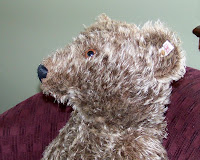"Hi there Steiff Gal:
Attached please 
Coco is 9’’ tall on his own and 13" if you count the wheels; he is 7.5 " long nose to backside. He is obviously made from mohair, the hat is moth eaten felt, and the wheels are wooden.
I have tried to find comparable Steiff items online or in reference guides but have been singularly unsuccessful. Are you familiar with this item and could you tell me more about it? Is it more common than I think?
Kind regards, Julius"Well, Steiffgal i
 s certainly "loco" over this Coco! This is a great item, a little more unusual than most, but still noted in the Steiff references. What you have here is what Steiff calls Pavian Coco or Baboon Coco. Overall, your Coco is 25 cm, made from grey and white mohair, is standing, and is wearing a red felt fez. Your version has eccentric, or asymmetric rolling wheels. (The "ex" in a product's article number is Steiff's way of saying the item is positioned on these playful rollers.) Coco on wheels was made overall from 1951 - 1961. He was produced in two versions: on regular wheels (1959 through 1961) and on eccentric wheels (1951 through 1957).
s certainly "loco" over this Coco! This is a great item, a little more unusual than most, but still noted in the Steiff references. What you have here is what Steiff calls Pavian Coco or Baboon Coco. Overall, your Coco is 25 cm, made from grey and white mohair, is standing, and is wearing a red felt fez. Your version has eccentric, or asymmetric rolling wheels. (The "ex" in a product's article number is Steiff's way of saying the item is positioned on these playful rollers.) Coco on wheels was made overall from 1951 - 1961. He was produced in two versions: on regular wheels (1959 through 1961) and on eccentric wheels (1951 through 1957). As for the fez, that is kind of interesting that Steiff would put it on this Coco. Steiffgal can think of two reasons why that might be the case:
First is the h
 istorical one. Steiff has a long-standing tradition of putting hats on monkeys. At the beginning of last century, Steiff introduced its now beloved "Record Peter", the sweet pull toy of a little seated monkey on four wheels. As early as 1913, Steiff made a felt version of the Record Peter monkey wearing a red felt suit and fez. Then in 1929, Steiff introduced another pull toy monkey on wheels except that he was standing, wearing a red fez, and on eccentric wheels. A picture of this 1929 monkey is here on the left for comparison; the photo is from Gunther Pfeiffer's 1892 -1943 Steiff Sortiment reference book.
istorical one. Steiff has a long-standing tradition of putting hats on monkeys. At the beginning of last century, Steiff introduced its now beloved "Record Peter", the sweet pull toy of a little seated monkey on four wheels. As early as 1913, Steiff made a felt version of the Record Peter monkey wearing a red felt suit and fez. Then in 1929, Steiff introduced another pull toy monkey on wheels except that he was standing, wearing a red fez, and on eccentric wheels. A picture of this 1929 monkey is here on the left for comparison; the photo is from Gunther Pfeiffer's 1892 -1943 Steiff Sortiment reference book.Seco
 nd is the "themed" one. Steiff also made a Coco baboon as a little bellhop, in a red outfit with a fez. This item was 28 cm and was a standing Coco dressed doll; he was called Pupp-Coco or Cocoli. This item is considered a real prize for collectors. Cocoli was made from 1952 through 1957, the same basic time frame as Julius' Coco on wheels. Steiffgal thinks that at the time, these baboons all got this little red fez as an accessory to keep their "look and feel" consistent. The hat is actually quite darling, don't you think? And really highlights his beautiful green and black pupil eyes. Cocoli is pictured here on the left.
nd is the "themed" one. Steiff also made a Coco baboon as a little bellhop, in a red outfit with a fez. This item was 28 cm and was a standing Coco dressed doll; he was called Pupp-Coco or Cocoli. This item is considered a real prize for collectors. Cocoli was made from 1952 through 1957, the same basic time frame as Julius' Coco on wheels. Steiffgal thinks that at the time, these baboons all got this little red fez as an accessory to keep their "look and feel" consistent. The hat is actually quite darling, don't you think? And really highlights his beautiful green and black pupil eyes. Cocoli is pictured here on the left. As for value and collectivity, Coco on wheels is certainly a top banana. As always, Steiffgal is not a formal appraiser and strongly believes that something is worth what someone else would actually pay for it. Steiffgal has seen this Coco on wheels in a book but never actually in person, for sale, or at auction. That all being said, Steiffgal would guestimate that he would be valued in the $250-400 range, given how little he comes on the market and that the collector's world seems finally to be coming back to life after a very slow 18 months.
Steiffgal hopes this little outing with this "Coco on the go" has been a pure joy ride for you!
Have a question about one of your Steiff treasures, mobile or otherwise? Let's talk! Click here to learn more.























